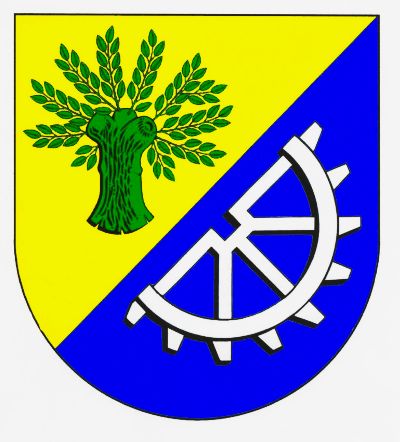Selk: Difference between revisions
Knorrepoes (talk | contribs) No edit summary |
Knorrepoes (talk | contribs) m (Text replace - "[[Literature" to "{{media}} [[Literature") |
||
| Line 20: | Line 20: | ||
The willow in the upper part of the arms is a canting symbol. The name Selk is probably derived from selje=willow. The lower half shows a water mill wheel for the historical mill in the Mühlenbach (mill brook), which operated for centuries. The colours gold and blue are derived from the arms of Schleswig. | The willow in the upper part of the arms is a canting symbol. The name Selk is probably derived from selje=willow. The lower half shows a water mill wheel for the historical mill in the Mühlenbach (mill brook), which operated for centuries. The colours gold and blue are derived from the arms of Schleswig. | ||
{{media}} | |||
[[Literature]] : Kommunale Wappenrolle Schleswig-Holstein | [[Literature]] : Kommunale Wappenrolle Schleswig-Holstein | ||
Revision as of 05:59, 9 July 2014
| Heraldry of the World Civic heraldry of Germany - Deutsche Wappen (Gemeindewappen/Kreiswappen) |
SELK
State : Schleswig-Holstein
District (Kreis) : Schleswig-Flensburg
Amt : Amt Haddeby
Official blazon
Von Gold und Blau schräglinks geteilt, oben eine grüne Kopfweide, unten ein schräggestelltes unterhalbes achtspeichiges silbernes Mühlrad.
Origin/meaning
The arms were officially granted on December 2, 2002.
The willow in the upper part of the arms is a canting symbol. The name Selk is probably derived from selje=willow. The lower half shows a water mill wheel for the historical mill in the Mühlenbach (mill brook), which operated for centuries. The colours gold and blue are derived from the arms of Schleswig.
Contact and Support
Partners:
Your logo here ?
Contact us
© since 1995, Heraldry of the World, Ralf Hartemink 
Index of the site
Literature : Kommunale Wappenrolle Schleswig-Holstein











